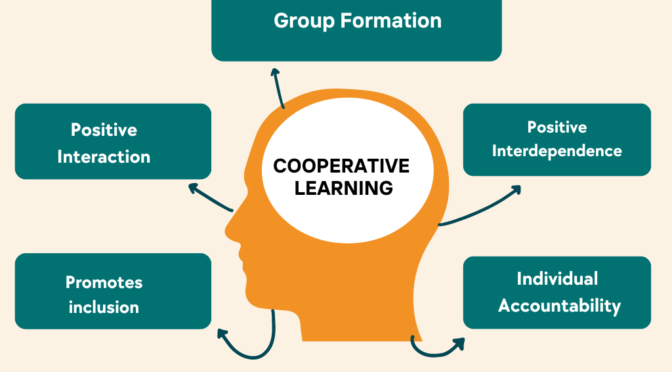Cooperative learning is an instructional approach that emphasizes student collaboration, teamwork, and active participation in the learning process. It involves organizing students into small groups to work together towards a common goal or complete a task.
Here are the key elements and benefits of cooperative learning:
- Group Formation: Students are grouped heterogeneously, meaning they are intentionally mixed based on their abilities, backgrounds, and skills. This diverse grouping promotes collaboration and allows students to learn from each other’s strengths and experiences.
- Positive Interdependence: Each group member has a specific role or task that contributes to the overall success of the group. Students understand that their individual performance directly impacts the success of the entire group, fostering a sense of accountability and shared responsibility.
- Face-to-Face Interaction: Cooperative learning encourages students to interact and communicate with one another. They engage in discussions, ask questions, share ideas, and provide feedback to their peers. This interaction promotes active engagement and deeper understanding of the content being studied.
- Individual Accountability: Although students work in groups, they are individually accountable for their learning and contributions. Each student is responsible for mastering the content and completing their assigned tasks. This accountability helps prevent free-riding and encourages all students to actively participate and contribute to the group’s success.
- Cooperative Skills Development: Cooperative learning provides opportunities for students to develop essential social and interpersonal skills. They learn to communicate effectively, listen attentively, resolve conflicts, and cooperate with others. These skills are transferable to various real-life situations and contribute to the overall social development of students.
- Positive Interactions: Cooperative learning fosters a positive and supportive learning environment. Students learn to respect and value each other’s opinions, ideas, and contributions. This positive interaction enhances motivation, self-esteem, and a sense of belonging among students.
- Academic Benefits: Cooperative learning has been found to improve academic achievement. Through discussions, explanations, and peer tutoring, students can deepen their understanding of concepts and develop critical thinking skills. Working collaboratively also exposes students to different perspectives and encourages them to consider alternative solutions, leading to enhanced problem-solving abilities.
- Promotes Inclusion: Cooperative learning promotes inclusion by providing opportunities for students with diverse abilities and backgrounds to work together. It values the contributions of every student and creates a supportive environment where students with disabilities or learning differences can actively participate and learn from their peers.
- Enhanced Motivation: Working in groups can increase student motivation and engagement. Cooperative learning allows students to take ownership of their learning, share responsibility, and benefit from the collective achievements of the group. This sense of belonging and shared success can inspire students to become more invested in their learning process.
Cooperative learning can be implemented across various subjects and grade levels. Teachers play a crucial role in structuring group tasks, providing clear instructions, facilitating discussions, and monitoring group dynamics. It is important to establish a positive classroom climate, teach students how to work collaboratively, and provide opportunities for reflection and feedback to ensure the success of cooperative learning in inclusive education.
Also Read : Buddy System

Also Visit : Prep with Harshita


Holgura mecanica
Aparatos de ajuste: importante para el operación fluido y eficiente de las dispositivos.
En el campo de la ciencia contemporánea, donde la productividad y la fiabilidad del equipo son de alta trascendencia, los dispositivos de ajuste tienen un rol crucial. Estos equipos adaptados están concebidos para ajustar y estabilizar componentes giratorias, ya sea en herramientas de fábrica, medios de transporte de transporte o incluso en aparatos domésticos.
Para los técnicos en mantenimiento de dispositivos y los técnicos, trabajar con dispositivos de calibración es crucial para asegurar el rendimiento estable y confiable de cualquier mecanismo rotativo. Gracias a estas soluciones innovadoras avanzadas, es posible limitar notablemente las movimientos, el ruido y la tensión sobre los cojinetes, prolongando la longevidad de piezas importantes.
Asimismo relevante es el papel que tienen los sistemas de balanceo en la atención al usuario. El soporte técnico y el mantenimiento permanente utilizando estos equipos posibilitan ofrecer servicios de excelente estándar, mejorando la contento de los consumidores.
Para los dueños de emprendimientos, la financiamiento en equipos de ajuste y sensores puede ser esencial para aumentar la eficiencia y productividad de sus equipos. Esto es particularmente trascendental para los dueños de negocios que dirigen reducidas y medianas empresas, donde cada punto vale.
Asimismo, los aparatos de ajuste tienen una gran implementación en el área de la prevención y el monitoreo de nivel. Posibilitan detectar posibles defectos, impidiendo mantenimientos elevadas y perjuicios a los equipos. También, los indicadores obtenidos de estos sistemas pueden utilizarse para maximizar métodos y potenciar la reconocimiento en buscadores de búsqueda.
Las áreas de utilización de los equipos de equilibrado incluyen diversas sectores, desde la fabricación de transporte personal hasta el monitoreo de la naturaleza. No importa si se habla de grandes producciones industriales o modestos establecimientos hogareños, los dispositivos de ajuste son esenciales para asegurar un desempeño efectivo y sin presencia de detenciones.